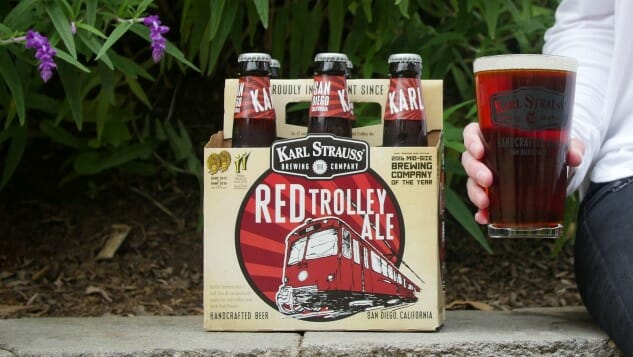My Month of Flagships: Karl Strauss Brewing Co. Red Trolley Ale
Photos via Karl Strauss Brewing Co.
This essay is part of a series this month, coinciding with the concept of Flagship February, wherein we intend to revisit the flagship beers of regional craft breweries, reflect on their influence within the beer scene, and assess how those beers fit into the modern beer world. Click here to see all the other entries in the series.
I remember a time in my beer-drinking life when the idea of “Irish red ale” was particularly attractive to me. Having never been a fan of the macro lagers one could expect to find at any given house party as a 21-year-old college student, my gateway into the “better beer” world often came in the form of amber-colored, lightly malty beers that offered a gentle introduction. Smithwick’s, the little brother to Guinness in the Diageo portfolio, was one of those sorts of beers I grew to appreciate for their relative restraint: They weren’t profoundly or artificially sweet, and they didn’t have the challenging bitterness of microbrew pale ales and IPAs of the time. Those amber and red ales, in other words, were the entry point I needed in order to start expanding my personal definition of what “beer” could be.
Of course, this was in central Illinois. Had I been in San Diego at the time, I have no doubt that one of the keys to my beer awakening would have been Karl Strauss Brewing Co.’s Red Trolley Ale. Brewed for more than 30 years now, Red Trolley is one of that great beer city’s oldest and most consistent flagships; an island of gentle malt in a city often defined by hoppy bitterness.
Defining “Irish red ale,” though, isn’t necessarily the easiest thing for a beer geek to do. There are a handful of classic commercial examples from the U.K., but in the hands of U.S. breweries the style can often mean whatever any given brewery decides it should. I’ve had Irish red ales that were extremely hoppy, or so pale they were barely amber; beers that were sticky sweet or almost dry as a bone. There’s little consensus on what the name implies.
In comparison to say, American amber ale, though, it is generally accepted that Irish red ale is less defined by hops—and probably uses U.K. hop varieties to boot. I also tend to think of them as less dominated by the caramel flavors of crystal malt, as many Irish red ale recipes instead incorporate some small amount of unmalted, roasted barley to contribute color and the slightest hint of dry roastiness. In that sense, they’re almost like an offshoot of Irish-style dry stout, simply not incorporating as much roasted barley, which allows the more delicate malty and hoppy notes to shine through.
It is, therefore, a style defined by subtlety and balance, and it makes for an unusual addition to this flagship series in the sense that it’s perhaps the only beer here that I’ve actually never sampled before. I therefore bring no real expectations or preconceptions into the following tasting: This is as objective as it gets.
-

-

-

-

-

-

-

-

-

-

-

-

-

-

-

-

-

-

-

-

-

-

-

-

-

-

-

-

-

-

-

-

-

-

-

-

-

-

-

-








































